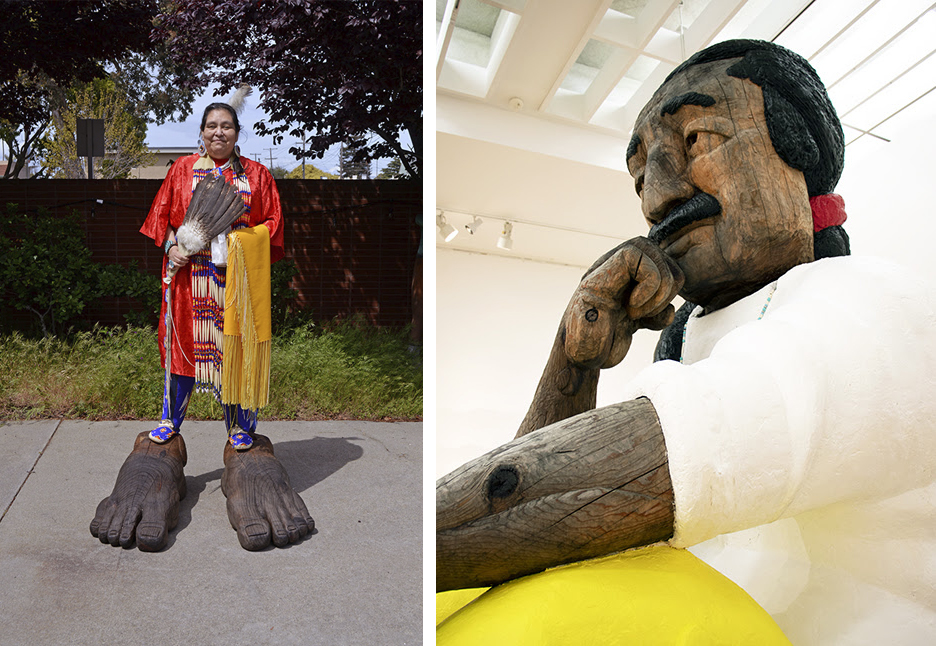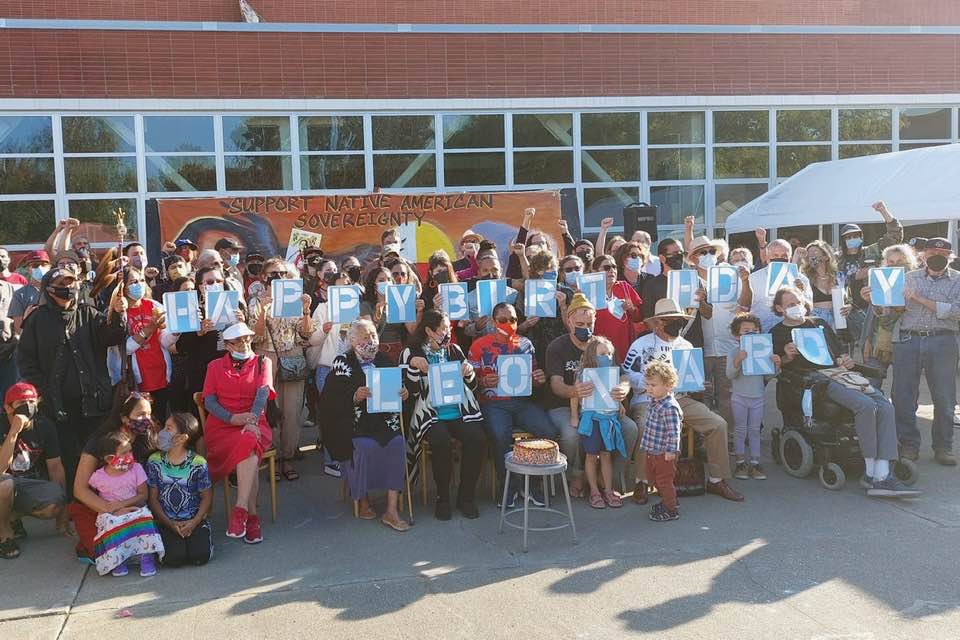
- Details
- By Native News Online Staff
RICHMOND, Calif. — The Richmond Art Center in Richmond, Calif. is hosting Time and Again, an exhibition centered on artist Rigo 23’s monumental sculptural tribute to imprisoned Leonard Peltier (Turtle Mountain Ojibwe).
Peltier has been incarcerated for the past 45 years for the murder of two FBI agents, who were shot and killed at Oglala on the Pine Ridge Indian Reservation in 1975. To many American Indians and others, Peltier, who turned 77-years-old on Sept. 12, is a symbol of an oppressive federal system that confines Native people to a dismal place in American society.
Want more Native News? Get the free daily newsletter today.
Rigo 23 is a well-known artist in the San Francisco Bay Area. He has exhibited his work internationally for over three decades, often placing murals, paintings, sculptures, and tile work in public venues.
The Time and Again exhibition’s main feature is a sculpture made from California redwood, foam, plywood, and metal that is based on a small hand-painted self-portrait Leonard Peltier created in prison. The statue’s 9’x6’ base replicates the dimensions of a traditional prison cell. Each time the work is shown, the exhibition incorporates selections from the growing collection of photographs of supporters standing in solidarity on the statue’s feet.
 Community celebrates Leonard Peltier’s 77th birthday on Sunday, Sept. 12 at Richmond Art Center. (Photo/Facebook)The sculpture became controversial when it was completed in 2016 and first shown at the Katzen Art Center at the American University, Washington D.C. Facing pressure from the FBI Agents Association and a bomb threat made to the university on the same day, the artwork was abruptly removed from display. It took one year to return the sculpture back to Rigo 23.
Community celebrates Leonard Peltier’s 77th birthday on Sunday, Sept. 12 at Richmond Art Center. (Photo/Facebook)The sculpture became controversial when it was completed in 2016 and first shown at the Katzen Art Center at the American University, Washington D.C. Facing pressure from the FBI Agents Association and a bomb threat made to the university on the same day, the artwork was abruptly removed from display. It took one year to return the sculpture back to Rigo 23.
Since its return to the artist, it has been exhibited at the Main Museum in Los Angeles (2018), SOMArts (2019) and most recently atop the roof of the San Francisco Institute of Art overlooking Alcatraz Island (2020).
The statue’s feet, which are detachable, have taken their own journey, traveling to significant sites of Native Resistance across the U.S. including Standing Rock, Alcatraz Island, Wounded Knee, Crow Dog’s Paradise, and the Pine Ridge Indian Reservation. Supporters have been invited to stand on the feet as an expression of solidarity – and be photographed. In summer 2021, Richmond Art Center also welcomed members of the community to do so.
The current exhibition includes materials such as original sketches for the banner “It’s 1999, Why is Leonard Peltier Still in Prison?” mounted outside the Berkeley Art Museum; photographs from the Tate Wikikuwa Museum installed at the deYoung Museum that same year; brochure and zine from theTate Wikikuwa Museum at the Warehouse Gallery in Syracuse University where the Leonard Peltier sculpture premiered, in 2011; and historical photographs by the late Michelle Vignes documenting seminal events in the history of the American Indian Movement.
Arthur Jacobs contributed to this article from Emeryville, Calif.
Exhibition: September 9 – November 18, 2021Richmond Art Center2540 Barrett Avenue, Richmond, CA 94804Gallery Hours: Thurs 10am-2pm, Sat 10am-2pm, or by appt 510-620-6772
More Stories Like This
Native American Designers You Should Know, Part 01Cherokee Nation Showcases Growing Film Slate with Fall Premieres of Incentive-Supported Titles
Chickasaw Artists Represent at Southwestern Association for Indian Arts in Santa Fe
Zuni Partners Share Community-Led Delapna:we Project at ATALM 2025 Conference
Celebrating 50 Years: The Rockwell Museum Looks to the Future with "Native Now"
Help us tell the stories that could save Native languages and food traditions
At a critical moment for Indian Country, Native News Online is embarking on our most ambitious reporting project yet: "Cultivating Culture," a three-year investigation into two forces shaping Native community survival—food sovereignty and language revitalization.
The devastating impact of COVID-19 accelerated the loss of Native elders and with them, irreplaceable cultural knowledge. Yet across tribal communities, innovative leaders are fighting back, reclaiming traditional food systems and breathing new life into Native languages. These aren't just cultural preservation efforts—they're powerful pathways to community health, healing, and resilience.
Our dedicated reporting team will spend three years documenting these stories through on-the-ground reporting in 18 tribal communities, producing over 200 in-depth stories, 18 podcast episodes, and multimedia content that amplifies Indigenous voices. We'll show policymakers, funders, and allies how cultural restoration directly impacts physical and mental wellness while celebrating successful models of sovereignty and self-determination.
This isn't corporate media parachuting into Indian Country for a quick story. This is sustained, relationship-based journalism by Native reporters who understand these communities. It's "Warrior Journalism"—fearless reporting that serves the 5.5 million readers who depend on us for news that mainstream media often ignores.
We need your help right now. While we've secured partial funding, we're still $450,000 short of our three-year budget. Our immediate goal is $25,000 this month to keep this critical work moving forward—funding reporter salaries, travel to remote communities, photography, and the deep reporting these stories deserve.
Every dollar directly supports Indigenous journalists telling Indigenous stories. Whether it's $5 or $50, your contribution ensures these vital narratives of resilience, innovation, and hope don't disappear into silence.
 The stakes couldn't be higher. Native languages are being lost at an alarming rate. Food insecurity plagues many tribal communities. But solutions are emerging, and these stories need to be told.
The stakes couldn't be higher. Native languages are being lost at an alarming rate. Food insecurity plagues many tribal communities. But solutions are emerging, and these stories need to be told.
Support independent Native journalism. Fund the stories that matter.
Levi Rickert (Potawatomi), Editor & Publisher

